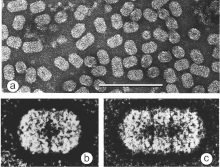Ourmiavirus
Ourmiavirus is a genus of positive-strand RNA viruses.[1] Cucurbits, cherry, and cassava serve as natural hosts. There are three species in this genus.[2][3] Diseases associated with this genus include: OuMV: yellowing and chlorotic spot symptoms.[2][4]
| Ourmiavirus | |
|---|---|
 | |
 | |
| TEM ofOurmia melon virus (bar, 100 nm), (b, c) commonest particle types (two- and three-disc), and genome | |
| Virus classification | |
| (unranked): | Virus |
| Realm: | Riboviria |
| Kingdom: | Orthornavirae |
| Phylum: | Lenarviricota |
| Class: | Miaviricetes |
| Order: | Ourlivirales |
| Family: | Botourmiaviridae |
| Genus: | Ourmiavirus |
| Species | |
| |
Structure

Viruses in the genus Ourmiavirus are non-enveloped, with icosahedral and bacilliform geometries, and T=1 symmetry. The diameter is around 18 nm, with a length of 30 nm.[2][4]
Life cycle
Viral replication is cytoplasmic. Entry into the host cell is achieved by penetration into the host cell. Replication follows the positive stranded RNA virus replication model. Positive stranded RNA virus transcription is the method of transcription. The virus exits the host cell by tubule-guided viral movement. Cucurbits, cherry, and cassava serve as the natural host.[2][4]
References
- Ayllón, MA; Turina, M; Xie, J; Nerva, L; Marzano, SL; Donaire, L; Jiang, D; ICTV Report Consortium (May 2020). "ICTV Virus Taxonomy Profile: Botourmiaviridae". The Journal of General Virology. 101 (5): 454–455. doi:10.1099/jgv.0.001409. PMC 7414452. PMID 32375992.
- "ICTV Report Botourmiaviridae".
- "Virus Taxonomy: 2020 Release". International Committee on Taxonomy of Viruses (ICTV). March 2021. Retrieved 16 May 2021.
- "Viral Zone". ExPASy. Retrieved 15 June 2015.